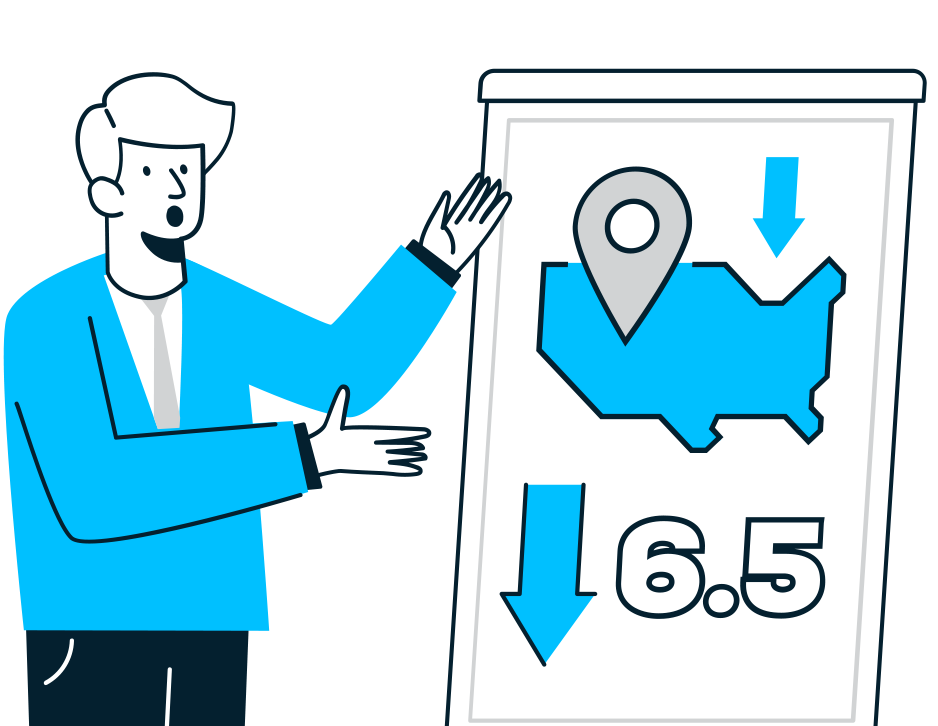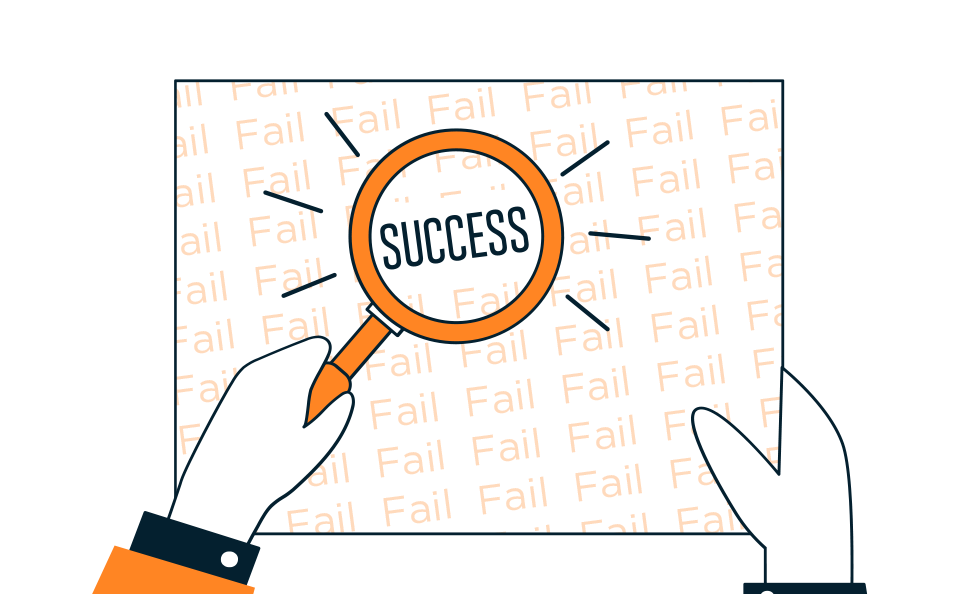What Percentage of New Businesses Fail in the US? 2024 Small Business Survival Rates & Insights from U.S. Bureau of Labor Statistics
“Seven out of ten small businesses in the U.S. fail within the first ten years.”
What!?
Last week that one sentence was enough to stop me dead in my tracks and change the entire course of the conversation I was having with my friend Victor. I was talking to Victor about small business marketing and how I could help his start-up get off the ground through various low-budget marketing ideas. Victor is starting a telehealth company to help people lose weight and be healthier. But his new start-up faces heavy competition, and his budget made it interesting. As I specialize in working with new and small businesses, I’m used to working out marketing strategies that fit a tight budget, so I was happy to help and work out the best marketing strategy to get his new company get off the ground. But our conversation took a turn when I heard the above statistic come out of his mouth. At first, it sounded like a lot. And, as a marketer and a small business owner, it’s hard to believe it. So… I did some research and decided to write this article. The purpose of this article isn’t to discourage you from starting a new business or give you a bunch of boring statistics. Rather, I’d like to A) Give you the raw data reported by various valid data sources and B) Give you some key marketing strategies to help your small business improve and have a better rate of survival! Before I start, I also wanted to take a minute to let you know that I offer marketing consulting services for any small business or new business looking to come up with a cost-effective and efficient marketing plan to help market their business online. Alright, with all that said, let’s dive into some statistics:Table of contents
What Percentage of New Businesses Fail in the US?
Why Do Most Businesses Fail?
The Role of Marketing in Business Success
Focus on Success, Not Failure
Important Business Tips for Entrepreneurs
How to Avoid the Pitfalls of High Competition
Failure Rate of Common Businesses & What Business Type is Most Successful
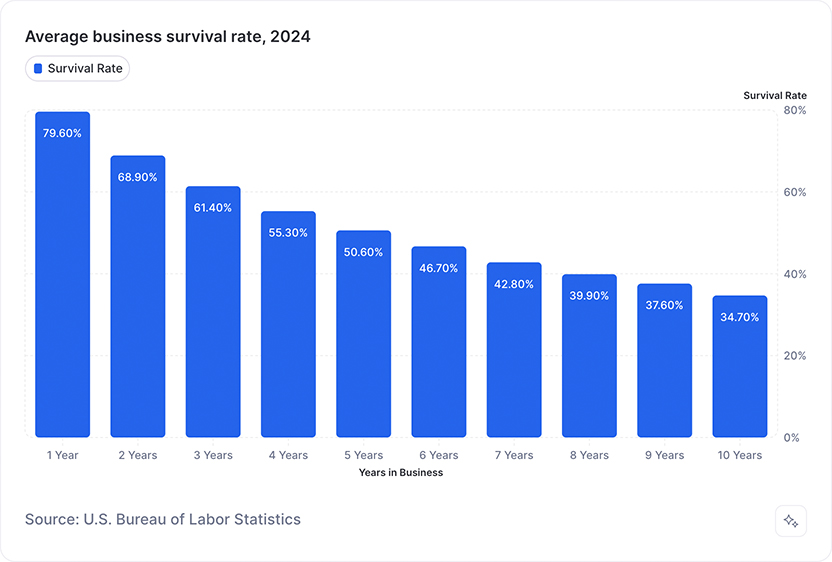

Important Business Tip for Entrepreneurs
I’ve seen too many business owners spend months, and sometimes even years, stuck in the planning phase, trying to find the perfect business idea, product, or service that will guarantee success. In trying to find the “perfect business,” you can often get bogged down by endless options and, trying to prevent failure, end up never starting at all. I know, its harsh of me to say, but I’ve seen it happen too many times and so I have to at least tell you my experience and my observation with regards to this. I’ve interviewed many successful entrepreneurs who swear by the “get in and swim” approach. They believe in trying, failing, learning, and trying again. In fact, a few years ago, I spoke with one of the richest men in the world, a man who sold his medical business for billions and made it onto the Forbes “Richest Men in The World” list. I was surprised to hear that his first three businesses went completely under, and it wasn’t until his tenth business attempt that he found success. So, if you’re starting a new business or trying to decide which one to start, remember that while the business, service, and product you choose can have an impact on your success, and yes, market research is important, don’t let the fear of failure paralyze you. Trust your gut and take the plunge. Smart planning and effective marketing are of course crucial, no matter what business you choose to start, but the key is to dive in and make it happen. Don’t worry about failing—focus on succeeding. And if you do fail, learn from it and start again. People with this mindset eventually succeed because they’re actively doing it, learning, and improving. I have seen silly business idea take off, and brilliant ideas go nowhere. I personally know people who started one business and found success, and I have friends who found success on their fifth, tenth, and even fourteenth business. So, my tip is, just go for it!
Reasons Why Most Businesses Fail
38%
35%
20%
19%
18%
15%
14%
10%
8%
7%
6%
5%
A Deeper Look Into The Reasons Why Most Businesses Fail
#01
Ran Out of Cash

5 Tips to Prevent Running Out of Cash
#02
No Market Need

The number one reason new businesses fail is that they don’t find the right product/market fit. Basically, this means you need to create something that’s faster, cheaper, or easier to use than what’s already out there, or you need to cater to a group of customers who aren’t being served well.
Another thing to think about is whether your product category is growing or shrinking. Here’s a quick rundown:
Competition Too High

How to Avoid the Pitfalls of High Competition
1- Ran Out of Money or Failed to Raise Sufficient Capital
Running out of money is a major reason why businesses fail. It’s one thing to start without enough capital, but it’s another to run out of funds because sales didn’t catch up quickly enough to sustain the business. This is where a solid marketing strategy comes in. A good marketing plan not only helps generate awareness but also drives sales and brings in customers at a steady pace. By effectively promoting your product or service, you can increase revenue streams and ensure that the initial capital you raised can keep the business running until it becomes self-sustaining. Consistent marketing efforts are key to maintaining cash flow and avoiding the dreaded “ran out of money” scenario.
2- No Market Need for Their Products or Services
Running out of money is a major reason why businesses fail. It’s one thing to start without enough capital, but it’s another to run out of funds because sales didn’t catch up quickly enough to sustain the business. This is where a solid marketing strategy comes in. A good marketing plan not only helps generate awareness but also drives sales and brings in customers at a steady pace. By effectively promoting your product or service, you can increase revenue streams and ensure that the initial capital you raised can keep the business running until it becomes self-sustaining. Consistent marketing efforts are key to maintaining cash flow and avoiding the dreaded “ran out of money” scenario.
3- Competition is Too High
Running out of money is a major reason why businesses fail. It’s one thing to start without enough capital, but it’s another to run out of funds because sales didn’t catch up quickly enough to sustain the business. This is where a solid marketing strategy comes in. A good marketing plan not only helps generate awareness but also drives sales and brings in customers at a steady pace. By effectively promoting your product or service, you can increase revenue streams and ensure that the initial capital you raised can keep the business running until it becomes self-sustaining. Consistent marketing efforts are key to maintaining cash flow and avoiding the dreaded “ran out of money” scenario.
4- Poor Business Model
Running out of money is a major reason why businesses fail. It’s one thing to start without enough capital, but it’s another to run out of funds because sales didn’t catch up quickly enough to sustain the business. This is where a solid marketing strategy comes in. A good marketing plan not only helps generate awareness but also drives sales and brings in customers at a steady pace. By effectively promoting your product or service, you can increase revenue streams and ensure that the initial capital you raised can keep the business running until it becomes self-sustaining. Consistent marketing efforts are key to maintaining cash flow and avoiding the dreaded “ran out of money” scenario.
5- Regulatory or Legal Challenges
Running out of money is a major reason why businesses fail. It’s one thing to start without enough capital, but it’s another to run out of funds because sales didn’t catch up quickly enough to sustain the business. This is where a solid marketing strategy comes in. A good marketing plan not only helps generate awareness but also drives sales and brings in customers at a steady pace. By effectively promoting your product or service, you can increase revenue streams and ensure that the initial capital you raised can keep the business running until it becomes self-sustaining. Consistent marketing efforts are key to maintaining cash flow and avoiding the dreaded “ran out of money” scenario.
6- Pricing or Cost Issues
Running out of money is a major reason why businesses fail. It’s one thing to start without enough capital, but it’s another to run out of funds because sales didn’t catch up quickly enough to sustain the business. This is where a solid marketing strategy comes in. A good marketing plan not only helps generate awareness but also drives sales and brings in customers at a steady pace. By effectively promoting your product or service, you can increase revenue streams and ensure that the initial capital you raised can keep the business running until it becomes self-sustaining. Consistent marketing efforts are key to maintaining cash flow and avoiding the dreaded “ran out of money” scenario.
7- Didn’t Have the Right Team
Running out of money is a major reason why businesses fail. It’s one thing to start without enough capital, but it’s another to run out of funds because sales didn’t catch up quickly enough to sustain the business. This is where a solid marketing strategy comes in. A good marketing plan not only helps generate awareness but also drives sales and brings in customers at a steady pace. By effectively promoting your product or service, you can increase revenue streams and ensure that the initial capital you raised can keep the business running until it becomes self-sustaining. Consistent marketing efforts are key to maintaining cash flow and avoiding the dreaded “ran out of money” scenario.
8- Product Mistimed
Running out of money is a major reason why businesses fail. It’s one thing to start without enough capital, but it’s another to run out of funds because sales didn’t catch up quickly enough to sustain the business. This is where a solid marketing strategy comes in. A good marketing plan not only helps generate awareness but also drives sales and brings in customers at a steady pace. By effectively promoting your product or service, you can increase revenue streams and ensure that the initial capital you raised can keep the business running until it becomes self-sustaining. Consistent marketing efforts are key to maintaining cash flow and avoiding the dreaded “ran out of money” scenario.
9- Poor Quality Product
Running out of money is a major reason why businesses fail. It’s one thing to start without enough capital, but it’s another to run out of funds because sales didn’t catch up quickly enough to sustain the business. This is where a solid marketing strategy comes in. A good marketing plan not only helps generate awareness but also drives sales and brings in customers at a steady pace. By effectively promoting your product or service, you can increase revenue streams and ensure that the initial capital you raised can keep the business running until it becomes self-sustaining. Consistent marketing efforts are key to maintaining cash flow and avoiding the dreaded “ran out of money” scenario.
10- Investors and Teams Were Not on the Same Page
Running out of money is a major reason why businesses fail. It’s one thing to start without enough capital, but it’s another to run out of funds because sales didn’t catch up quickly enough to sustain the business. This is where a solid marketing strategy comes in. A good marketing plan not only helps generate awareness but also drives sales and brings in customers at a steady pace. By effectively promoting your product or service, you can increase revenue streams and ensure that the initial capital you raised can keep the business running until it becomes self-sustaining. Consistent marketing efforts are key to maintaining cash flow and avoiding the dreaded “ran out of money” scenario.
11- Failed to Execute the Plan or Adapt to Market Changes
Running out of money is a major reason why businesses fail. It’s one thing to start without enough capital, but it’s another to run out of funds because sales didn’t catch up quickly enough to sustain the business. This is where a solid marketing strategy comes in. A good marketing plan not only helps generate awareness but also drives sales and brings in customers at a steady pace. By effectively promoting your product or service, you can increase revenue streams and ensure that the initial capital you raised can keep the business running until it becomes self-sustaining. Consistent marketing efforts are key to maintaining cash flow and avoiding the dreaded “ran out of money” scenario.
12- Burned Out or Lack of Passion
Running out of money is a major reason why businesses fail. It’s one thing to start without enough capital, but it’s another to run out of funds because sales didn’t catch up quickly enough to sustain the business. This is where a solid marketing strategy comes in. A good marketing plan not only helps generate awareness but also drives sales and brings in customers at a steady pace. By effectively promoting your product or service, you can increase revenue streams and ensure that the initial capital you raised can keep the business running until it becomes self-sustaining. Consistent marketing efforts are key to maintaining cash flow and avoiding the dreaded “ran out of money” scenario.
Retail Business Survival Rates

Real Estate Business Survival Rates
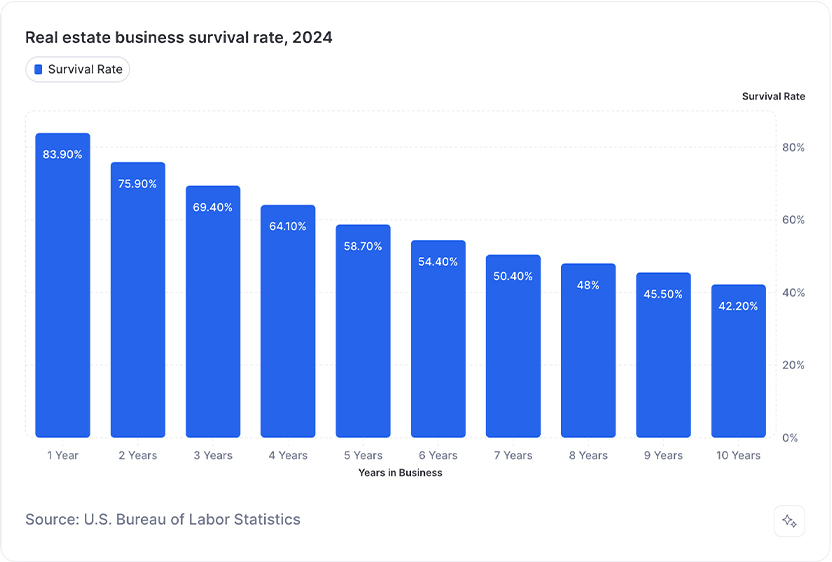
Restaurant Survival Rate
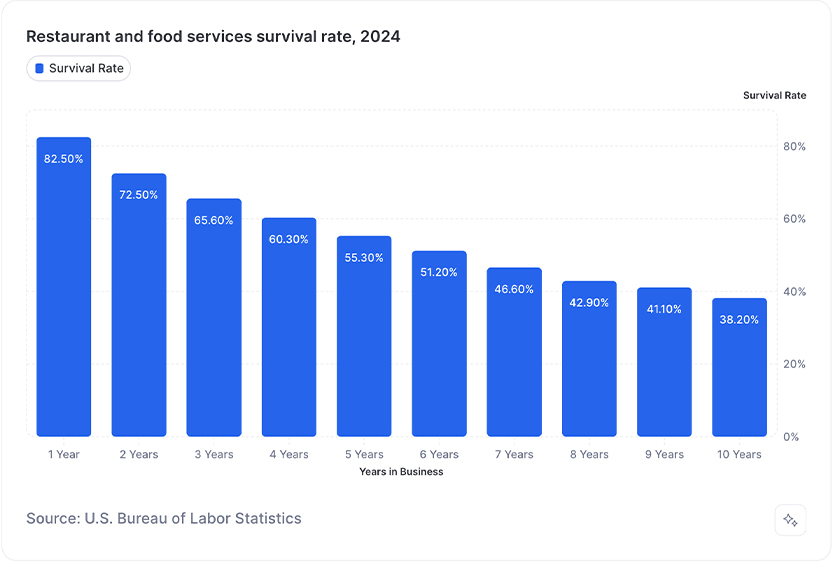
How Many Service-Based Businesses Fail?
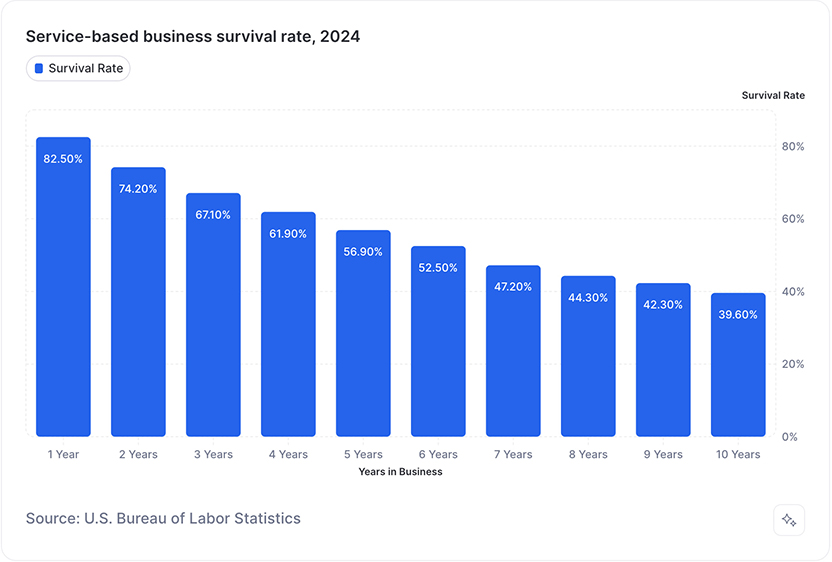

So, Which Businesses Are Most Likely to Succeed?
When it comes to starting a business, understanding the odds of success in different industries can help guide your decisions.
Based on the survival rates we’ve looked at, here’s a breakdown of which types of businesses are most likely to stand the test of time, ranked from the most to the least likely to succeed:
#01
Service-Based Businesses
Why They Succeed:
Real Estate Businesses
Why They Succeed:
#03
Retail Businesses
Why They Succeed (and Struggle):
Restaurants
Why They Struggle:


Seven Steps to Start a Business and Increase Your Chances of Success
Identify a Viable Business Idea
Conduct Thorough Market Research
Create a Solid Business Plan
Secure Funding
Build a Strong Online Presence
Launch with a Marketing Strategy
Stay Adaptable and Keep Learning

Free Homepage Design
Get a stunning, custom homepage for free!
Limited-time offer—claim yours now!



